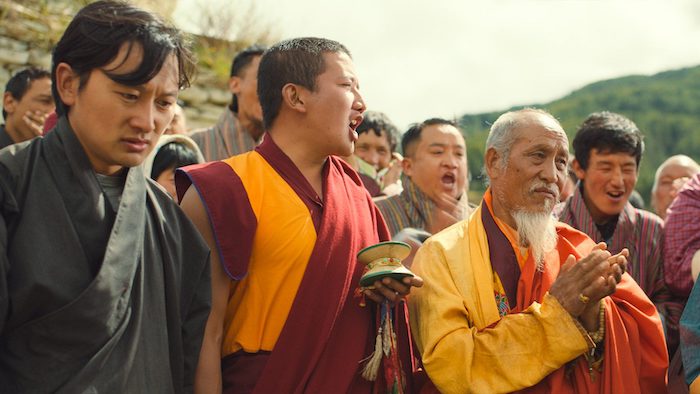Synopsis
Bhutanese director-writer Pawo Choyning Dorji tells a story of change and transition in Bhutan through satirical commentary in The Monk and the Gun. Set against the backdrop of Bhutan's democratic transition in 2006, the story weaves together two journeys: that of Ron, an American antique arms collector, who, along with his local guide, is on a quest to find a 19th-century American Civil War rifle in the remote village of Ura; and Tashi, a young monk wandering through the serene mountains of the village in search of a pair of guns requested by his lama (spiritual leader). Tashi’s lama wants to "make things right" considering Bhutan's upcoming election and whose motives for wanting the gun are initially unclear.
Democracy from above
The film is set just after Bhutan — the last country in the world to introduce television and the internet — opens to globalization. The village of Ura is abuzz not only with newly imported Western goods such as soda pop and James Bond movies but also with the anticipation of transitioning to a new political system. Bhutan's king has agreed to abdicate so that his country can embark on becoming the world's youngest democracy. But Bhutan has no prior experience with democratic elections, so government officials feel they must teach the residents of Ura how to vote by organizing a mock election.

The legitimacy of a democratic exercise requires the existence of diverse voter factions. This becomes a problem for government officials in idyllic Ura, where people have lived under the same monarchical system for centuries. In fact, it is a system with which Ura’s citizens seem content, making them not particularly inclined to want to pick their own leader. To overcome this predicament, officials try to teach the people how to stage rallies for their made-up political parties and even how to brawl with opposition groups. In other words, political polarization is something that has to be taught to the people of Ura. In one scene, an elderly woman asks, “Why are you teaching us to be so rude? This is not who we are.”
Yet the villagers are repeatedly reminded by their government officials that democratic elections are a ‘gift’ for which people in other parts of the world had to fight or even give their lives. Dorji, the film’s director, raises thoughtful questions about the place of democratic elections in Ura, where notions of civic duty are often rooted in traditional Buddhist practices and Himalayan culture.
I would have liked to see the film further explore ideas around democracy, which can often take various forms and practices in non-Western societies.
The reluctance to embrace change in Ura becomes evident as the colour-coded mock election, featuring the Red, Blue, and Yellow parties, culminates in a resounding victory for the Yellow candidate. Why? Because yellow is the colour associated with the King of Bhutan.
Embracing change through tradition
The film leaves the lama’s intentions to viewers’ speculation until the very end of the film, including what the guns he seeks represents. There is a glimpse of a juxtaposition when Ron, the American antique collector, and his guide nervously contemplate why a monk might need a gun. Will he use it to commit violence? For their part, Ura’s villagers show no sign of concern at the sight of a monk marching through the village with a rifle over his shoulder; rather, the monk is offered a ride to his destination. The scene lays bare the contrast between the urban cynicism and mistrust — as expressed by the antique collector and his guide (and perhaps most of the audience?) — on one side, and the trusting nature of the people of Ura on the other.
The film explores the value attributed to the gun: Ron’s pursuit of the gun is materialistic, but for the monks, the gun is a symbol ushering in a new beginning for Bhutan — the elderly lama gathers everyone for a ceremony as the heartwarming finale shows the audience how centuries-old traditions can ease a society’s transition to this new era, as the monks bury the guns in a stupa (a Buddhist shrine used commonly for meditation) to herald a new chapter for Bhutanese society. The film’s hopeful ending illustrates how traditions can pave the way for people to accept and adapt to an ever-changing world.
About Vancouver International Film Festival (VIFF)
Founded in 1982, The Greater Vancouver International Film Festival Society is a not-for-profit cultural organization that operates the internationally acclaimed Vancouver International Film Festival (VIFF) and the year-round programming of the theatres at the VIFF Centre. VIFF encourages understanding of the world’s cultures through the art of cinema and believes that film has a unique ability to celebrate the complexity of the human condition and that it is our responsibility to steward that power toward creating meaningful change in our world.
